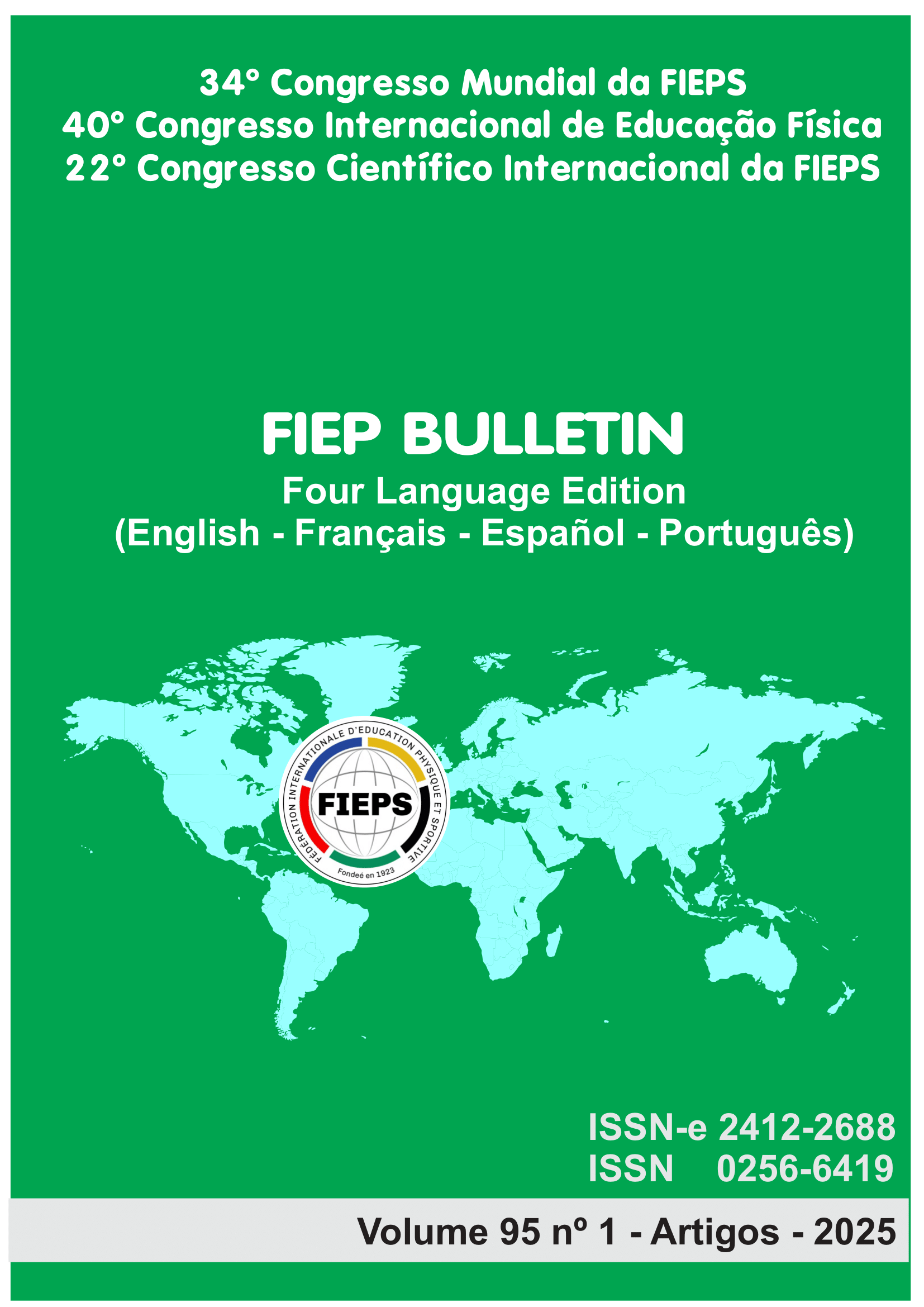IMPACT OF THE PHYSICAL EDUCATION TEACHER ON STUDENTS' POSITIVE AFFECT
DOI:
https://doi.org/10.16887/yc2cs579Keywords:
Novelty, basic psychological needs, self-determination theory, physical activity, positive affectAbstract
Introduction: Physical education in Mexico faces challenges in the motivation and engagement of high school students. This study aims to analyze the interrelationships between the quality of homework presentation by the physical education teacher, the satisfaction of the need for novelty and the positive affect of high school students in Aguascalientes, Mexico. Methodology: The research, correlational and cross-sectional in nature, involved 398 students aged 11 to 14 years. Descriptive analyses, reliability and correlations calculations using SPSS v27, as well as confirmatory factor analysis and structural equations with AMOS v24 were used. Results: The results reveal that when testing the models, the results indicated that task presentation was positively and significantly associated with novelty satisfaction as well as novelty satisfaction with positive affect, and when a direct relationship was made between task presentation and positive affect, this relationship was not significant, indicating that there was a total mediation by novelty satisfaction. Conclusion: It is concluded that the quality of task presentation by the physical education teacher significantly influences students' need for novelty satisfaction and is associated with their positive affect, which could have important implications for students' motivation and engagement in physical education classes.
Downloads
References
Aguilar-Herrero, M. D., García-Fernández, C. M., & Gil, C. (2021). Efectividad de un programa educativo en Educación Física para fomentar las habilidades socioafectivas y prevenir la violencia en educación primaria. Retos: Nuevas Tendencias en Educación Física, Deporte y Recreación, 41, 492-501. https://doi.org/10.47197/retos.v0i41.82683 DOI: https://doi.org/10.47197/retos.v0i41.82683
Almanza-Barilla, J. C. (2024). Exteriencias biopsicosociales para fortalecer los estilos de vida saludable: análisis desde la educación física en tres instituciones rurales del municipio de Planeta Rica Córdoba Colombia. Ciencia Latina Revista Científica Multidisciplinar. 8(4), 4106-4125. DOI: https://doi.org/10.37811/cl_rcm.v8i4.12637
https://doi.org/10.37811/cl_rcm.v8i4 DOI: https://doi.org/10.37811/cl_rcm.v8i4
Barbosa-Luna, A. E., Tristán, J. L., Tomás, I., González, A., & López-Walle, J. M. (2017). Climas motivacionales, motivación autodeterminada, afectos y burnout en deportistas: enfoque multinivel. Acción Psicológica, 14(1), 105-118. https://- doi.org/10.5944/ap.14.1.19266 DOI: https://doi.org/10.5944/ap.14.1.19266
Browne, M. W., & Cudeck, R. (1992). Alternative ways of assessing model fit. DOI: https://doi.org/10.1177/0049124192021002005
Sociological Methods & Research, 21(2), 230-258. https://doi.org/10.1177/0049124192021002005 DOI: https://doi.org/10.1177/0049124192021002005
Chen, W., Hendricks, K., & Archibald, K. (2011). Assessing pre-service teachers’ quality teaching practices. Educational Research and Evaluation, 17(1), 13– 32. https://doi.org/10.1080/13803611.2011.578008 DOI: https://doi.org/10.1080/13803611.2011.578008
Cheung, G. W., & Rensvold R. B.(2002). Evaluating Goodness-of-Fit Indexes for Testing Measurement Invariance. Structural Equation Modeling: A Multidisciplinary Journal,9(2),233-255. https://doi.org/10.1207/S15328007SEM0902_5 DOI: https://doi.org/10.1207/S15328007SEM0902_5
Diario Oficial de la Federación. (2014). Reglamento de la Ley General de Salud en Materia de Investigación para la Salud. https://www.diputados.gob.mx/LeyesBiblio/regley/Reg_LGS_MIS.pdf
Esqueda-Valerio, E. I., Vargas.Batres, D. M., Ovalle-Hernández, J. D., Vergara-Torres,
A. P., López-Walle, J. M., & Tristán, J. (2023). Oportunidad para aprender de feedback correctivo, necesidades psicológicas y afectos positivos en alumnos de educación física. Revista de Ciencias del Ejercicio, 18(2), 15-25. DOI: https://doi.org/10.29105/rcefod.v18i2.95
Esqueda-Valerio, E. I., Vargas-Batres, D. M., Vergara-Torres, A. P., López-Walle, J. M., Ramírez-Nava, R., & Tristán, J. (2024). Cómo se comunican las tareas importa:
necesidades psicológicas y ser físicamente activo en Educación Física. Revista Técnico-Científica del Deporte Escolar. Educación Física y Psicomotricidad. 10(1), 47-70. https://doi.org/10.17979/sportis.2024.10.1.9972 DOI: https://doi.org/10.17979/sportis.2024.10.1.9972
Fernández-Espínola, C., & Almagro, B. J. (2019). Relación entre motivación e inteligencia emocional en Educación Física: una revisión sistemática. Retos: Nuevas Tendencias en Educación Física, Deporte y Recreación, 36,478-483. DOI: https://doi.org/10.47197/retos.v36i36.64968
Fernández-Espínola, C., Almagro, B. J., & Tamayo-Fajardo, J. A. (2020). Predicción de la intención de ser físicamente activo del alumnado de Educación Física: un modelo mediado por la necesidad de novedad. Retos: Nuevas Tendencias en Educación Física, Deporte y Recreación, 37, 442-448. DOI: https://doi.org/10.47197/retos.v37i37.70946
https://doi.org/10.47197/retos.v37i37.70946 DOI: https://doi.org/10.47197/retos.v37i37.70946
Ferrando, P. J. & Anguiano-Carrasco, C. (2010). El análisis factorial como técnica de investigación en psicología. Papeles del Psicólogo, 31(1), 18–33.
Gil-Madrona, P., Pascual-Francés, L., Jordá-Espi, A., Mujica-Johnson, F., & Fernández-Revelles, A. B. (2020). Afectividad e interacción motriz de los jeugos motores populares en la escuela. Apunts. Educación Física y Deportes, 139, 42-48. https://doi.org/10.5672/apunts.2014-0983.es.(2020/1).139.06 DOI: https://doi.org/10.5672/apunts.2014-0983.es.(2020/1).139.06
González-Cutre, D. (2017). ¿Qué papel juega la satisfacción de la necesidad de novedad en la motivación humana y cuál es su aplicación al ámbito de la activdad física y el deporte?. Revista de Educación, Motricidad e Investigación. 9, 1-2. DOI: https://doi.org/10.33776/remo.v0i9.3284
González-Cutre, D., Romero-Elías, M., Jiménez-Loaisa, A., Beltrán-Carrillo, V. J., & Hagger, M. S. (2020). Testing the need for novelty as a candidate need in basic psychological needs theory. Motivation and Emotion 44(2), 295-314. https://doi.org/10.1007/s11031-019-09812-7 DOI: https://doi.org/10.1007/s11031-019-09812-7
Hu, L.-T., & Bentler, P. M. (1995). Evaluating model fit. In R. H. Hoyle, Structural equation modeling: Concepts, issues, and applications. Thousand Oaks, CA:Sage Publications, Inc.
Hu, L. T., & Bentler, P. M. (1999). Cutoff criteria for Fit Indexes in Covariance Structure Analysis: Conventional criteria versus new alternatives. Structural Equation Modeling, 6, 1-55. http://dx.doi.org/10.1080/10705519909540118 DOI: https://doi.org/10.1080/10705519909540118
Muñoz-Arroyave, V., Lavega-Burgués, P., Costes, A., Damián, S., & Serna, J. (2020). Los juegos motores como recurso pedagógico para favorecer la afectividad desde la educación física. Retos: Nuevas Tendencias en Educación Física, Deporte y Recreación, 38, 166-172 https://doi.org/10.47197/retos.v38i38.76556 DOI: https://doi.org/10.47197/retos.v38i38.76556
Muthén, B. & Kaplan D. (1985). A comparison of some methodologies for the factor analysis of non-normal Likert variables. British Journal of Mathematical and Statistical Psychology, 38(2), 171–189. https://doi.org/10.1111/j.2044- 8317.1985.tb00832.x DOI: https://doi.org/10.1111/j.2044-8317.1985.tb00832.x
Muthén, B. & Kaplan D. (1992). A comparison of some methodologies for the factor analysis of non-normal Likert variables: A note on the size of the model. British Journal of Mathematical and Statistical Psychology, 45(1), 19–30. https://doi.org/10.1111/j.2044-8317.1992.tb00975.x DOI: https://doi.org/10.1111/j.2044-8317.1992.tb00975.x
Pandey, P., & Pandey, M. M. (2015). Research methodology: Tools and techniques.
Romania: Bridge Center.
Pinedo-González, R., Arroyo-González, M. J., & San-José, C. C. (2017) Afectividad positiva y negativa en el futuro docente: relaciones con su rendimiento académico, salud mental y satisfacción con la vida. Contextos Educativos, Revista de Educación, 20, 11-26. https://doi.org/10.18172/con.2996 DOI: https://doi.org/10.18172/con.2996
Rink, J. E. (1993). Teaching physical education for learning. Columbus: Times a Mosby College Publishing.
Rojo-Ramos, J., Polo-Campos, I., Gomez-Paniagua, S., & Galán-Arroyo, C. (2024). Satisfacción y frustración con la novedad de los contenidos de educación física
en estudiantes de secundaria. Retos. Nuevas Tendencias en Educación Física, Deporte y Recreación, 54, 436-455
Ryan, R. M., & Deci, E. L. (2017). Self-determination theory: Basic psychological needs in motivation, development, and wellness. Guilford Press. https://doi.org/10.1521/978.14625/28806 DOI: https://doi.org/10.1521/978.14625/28806
Tristán, J., López-Walle, J. M., Tomás, I., Cantú-Berrueto, A., Pérez-García, J. A., & Castillo, I. (2016). Development and validation of the coach’s task presentation scale: A quantitative self-report instrument. Psychology of Sport and Exercise, 25, 68–77. https://doi.org/10.1016/j.psychsport.2016.04.002 DOI: https://doi.org/10.1016/j.psychsport.2016.04.002
Tristán, J., Vergara-Torres, A., Vanegas-Farfano, M., Espino-Verdugo, F., Medina Corrales, M., & Tomás, I. (2019). Presentación de las tareas proporcionado por el profesor, necesidades psicológicas y vitalidad subjetiva en alumnos de educación física. Cuadernos de Psicología del Deporte, 19(3), 190-204 DOI: https://doi.org/10.6018/cpd.358561
Vergara-Torres, A. P., Tristán, J., López-Walle, J. M., González-Gallegos, A., Pappous,
A. S., & Tomás, I. (2021). Quality of the physical education teacher’s instruction in the perspective of self-determination. Frontiers in Psychology, 12,749678 https://doi.org/10.3389/fpsyg.2021.708441 DOI: https://doi.org/10.3389/fpsyg.2021.708441
Watson, D., Clark, L. A., & Tellegen, A. (1988). Development and validation of brief measures of positive and negative affect: the PANAS scales. Journal of Personality and Social Psycho- logy,54(6),1063–1070. https://doi.or- g/10.1037//0022-3514.54.6.1063 DOI: https://doi.org/10.1037//0022-3514.54.6.1063
Wheaton, B., Muthén, B., Alwin, D. F., & Summers, G. F. (1977). Assessing reliability and stability in panel models. Sociological Methodology, 8, 84-136. https://doi.org/10.2307/270754 DOI: https://doi.org/10.2307/270754
Widaman, K. F. (1985). Hierarchically Nested Covariance Structure Models for Multitrait-Multimethod Data. Applied Psychological Measurement, 9(1), 1-26. https://doi.org/10.1177/014662168500900101 DOI: https://doi.org/10.1177/014662168500900101
Downloads
Published
Issue
Section
License
Autores que publicam nesta revista concordam com os seguintes termos:- Autores mantém os direitos autorais e concedem à revista o direito de primeira publicação, com o trabalho simultaneamente licenciado sob a Licença Creative Commons Attribution que permite o compartilhamento do trabalho com reconhecimento da autoria e publicação inicial nesta revista.
- Autores têm autorização para assumir contratos adicionais separadamente, para distribuição não-exclusiva da versão do trabalho publicada nesta revista (ex.: publicar em repositório institucional ou como capítulo de livro), com reconhecimento de autoria e publicação inicial nesta revista.
- Autores têm permissão e são estimulados a publicar e distribuir seu trabalho online (ex.: em repositórios institucionais ou na sua página pessoal) a qualquer ponto antes ou durante o processo editorial, já que isso pode gerar alterações produtivas, bem como aumentar o impacto e a citação do trabalho publicado (Veja O Efeito do Acesso Livre).










